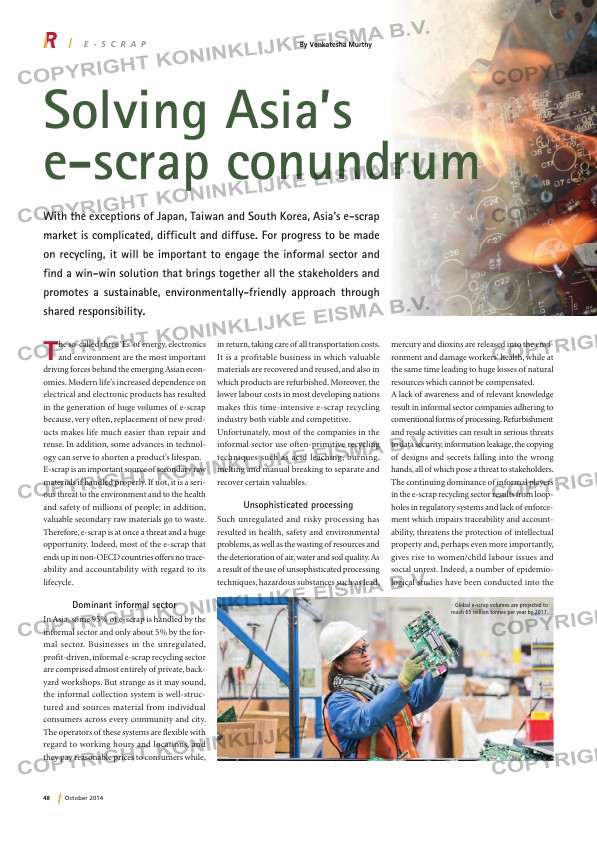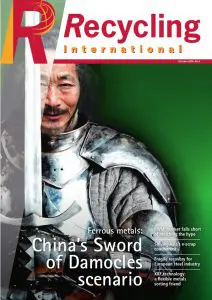Page 48 from: October 2014

48 October 2014
The so-called three ‘Es’ of energy, electronics and environment are the most important
driving forces behind the emerging Asian econ-
omies. Modern life’s increased dependence on
electrical and electronic products has resulted
in the generation of huge volumes of e-scrap
because, very often, replacement of new prod-
ucts makes life much easier than repair and
reuse. In addition, some advances in technol-
ogy can serve to shorten a product’s lifespan.
E-scrap is an important source of secondary raw
materials if handled properly. If not, it is a seri-
ous threat to the environment and to the health
and safety of millions of people; in addition,
valuable secondary raw materials go to waste.
Therefore, e-scrap is at once a threat and a huge
opportunity. Indeed, most of the e-scrap that
ends up in non-OECD countries offers no trace-
ability and accountability with regard to its
lifecycle.
Dominant informal sector
In Asia, some 95% of e-scrap is handled by the
informal sector and only about 5% by the for-
mal sector. Businesses in the unregulated,
profit-driven, informal e-scrap recycling sector
are comprised almost entirely of private, back-
yard workshops. But strange as it may sound,
the informal collection system is well-struc-
tured and sources material from individual
consumers across every community and city.
The operators of these systems are flexible with
regard to working hours and locations, and
they pay reasonable prices to consumers while,
in return, taking care of all transportation costs.
It is a profitable business in which valuable
materials are recovered and reused, and also in
which products are refurbished. Moreover, the
lower labour costs in most developing nations
makes this time-intensive e-scrap recycling
industry both viable and competitive.
Unfortunately, most of the companies in the
informal sector use often-primitive recycling
techniques such as acid leaching, burning,
melting and manual breaking to separate and
recover certain valuables.
Unsophisticated processing
Such unregulated and risky processing has
resulted in health, safety and environmental
problems, as well as the wasting of resources and
the deterioration of air, water and soil quality. As
a result of the use of unsophisticated processing
techniques, hazardous substances such as lead,
mercury and dioxins are released into the envi-
ronment and damage workers’ health, while at
the same time leading to huge losses of natural
resources which cannot be compensated.
A lack of awareness and of relevant knowledge
result in informal sector companies adhering to
conventional forms of processing. Refurbishment
and resale activities can result in serious threats
to data security, information leakage, the copying
of designs and secrets falling into the wrong
hands, all of which pose a threat to stakeholders.
The continuing dominance of informal players
in the e-scrap recycling sector results from loop-
holes in regulatory systems and lack of enforce-
ment which impairs traceability and account-
ability, threatens the protection of intellectual
property and, perhaps even more importantly,
gives rise to women/child labour issues and
social unrest. Indeed, a number of epidemio-
logical studies have been conducted into the
E – s c r a p By Venkatesha Murthy
Global e-scrap volumes are projected to
reach 65 million tonnes per year by 2017.
With the exceptions of Japan, Taiwan and South Korea, Asia’s e-scrap
market is complicated, difficult and diffuse. For progress to be made
on recycling, it will be important to engage the informal sector and
find a win-win solution that brings together all the stakeholders and
promotes a sustainable, environmentally-friendly approach through
shared responsibility.
Solving Asia’s
e-scrap conundrum
RI8-Asia e-scrap.indd 48 06-10-14 14:06



